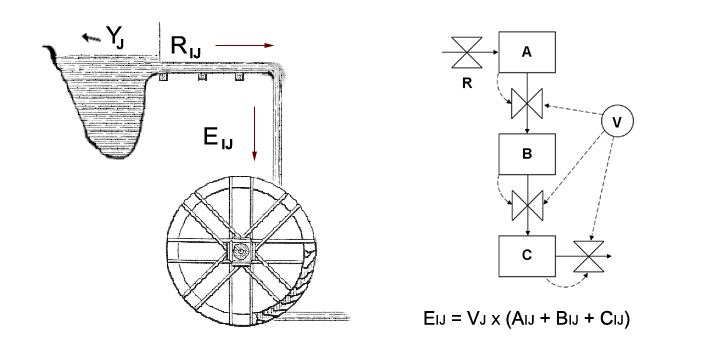Model 0’s portrait of multi-sectoral interdependence has been structured on an input/output matrix of physical assets giving up their economic lives in creating the next generation of goods. Our discussion of equilibrium has been under obvious strains to reference these dynamics without actually giving place to them. We can now begin to relieve this tension by presenting the exchanges matrix EIJK in its dynamic context.
Economic adjustment occurs in terms of newly created goods more or less replenishing stocks of the goods exhausted in the processes of creation. Assets are continually being worked-off or built-up in search of optimal operating conditions. The figure below illustrates the continuous nature of these interchanges.

In what can only be a small isolated economy, sector J is a public utility responsible for a waterway. The output YJ of this sector is flow through a canal (portrayed here in cross-section) that is diverted along the way for the use of other sectors that might employ the flow for navigation, irrigation, power generation, etc
One such sector I is a mill driven by a waterwheel. RIJ is the rate at which sector I takes good J off the market and into its own asset stock, i.e.: into a millpond where the flow’s potential energy builds up before engaging the wheel. EIJ, by contrast, is the rate of flow that engages the waterwheel, ‘turning the wheel of industry’. Where RIJ replenishes assets that are being used up, the flow of material through the mill EIJ represents assets giving up their useful economic lives (the potential energy of water flowing from a higher to a lower level) in creating the next generation of goods.
This process is analogized by the third order delay at our figure’s right. Here we have a driving function R delayed by passing through a series of state variables A, B, and C. The physical asset of water flowing through the mill can be envisioned as the state variables actuating this higher-ordered delay. E is equated to the average rate V•(A+B+C) at which assets are passing through the delay structure, where V governs the rate at which assets pass along the dimension of time toward exhaustion.
The parameter VJ (mnemonic: velocity or variability) called forth by this analogy distinguishes the logistical identities of the goods J. VJ represents a good’s physical durability in terms of the accountant’s turnover rate, which is a dimensionless fraction per year. It might embody the perishability of food stuffs, the economic order quantity of an inventoried item, the tendency for consumer items to go out of style, or of heavy equipment to wear out, become technically obsolete, or require maintenance.
Model 0 presumes that a good J’s turnover fraction VJ can be regarded as constant. This hypothesis might of course be replaced by any number of more satisfyingly complex formulations; but it serves Model 0’s purpose of amalgamating the simplest structural elements that can actually function together as an analogy to economic adjustment.
Auditors contemplating some expansion of their own model’s complexity with respect to VJ might be usefully directed to our general essay on the turnover fraction. We also suggest examining the sensitivity of Model 0 to changes in VJ before launching into any effort to refine this concept.